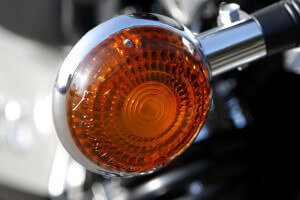Lifesaver Checks and Rear Observation
Rear observation refers to a combination of mirror checks and looking behind which ensures you are always fully aware of what is happening behind you.
Before you signal, change direction or speed you must know how your actions will affect following traffic.
You also have to know when traffic is likely to overtake or come alongside you.
Not all motorcycles are fitted with mirrors, and mirrors don’t always give a clear view behind.
Looking behind is important because the view through the mirrors on some motorcycles is restricted, leaving significant blind spots.
There will be times when you need to look round to see the full picture.
Looking behind also warns other drivers that you may be about to signal or alter course.
The motorcycle lifesaver check
The lifesaver is a last check over the shoulder into the blind spot to make sure nothing unexpected is happening before committing yourself to a manoeuvre.
If you are turning, use it to check the blind spot on the side to which you intend to turn.
Use your judgement about when to use it.
In congested urban situations a lifesaver check is normally essential, especially when turning right into a minor road.
During high speed overtaking, when you are certain what is happening behind, it is often safer to keep your eyes on what is happening ahead.
The blind area
The blind area is the area behind and to either side of you which isn’t covered by mirrors. It’s very important to check for traffic in this area before:
- Moving off
- Changing direction
- Changing lane
When should you look behind?
Use judgement in deciding when to look behind.
Obviously when you are looking behind you are not looking ahead. This could be hazardous if, for example, you are close to the vehicle in front or if you are overtaking at speed.
Equally there are situations when it is dangerous not to look behind, such as a right turn into a minor road.
Take rear observation when you about to change position or speed as you approach and negotiate a hazard.
This might be before
- Moving off
- Turning left or right
- Overtaking
- Changing lanes
- Slowing or stopping
WARNING – Looking over your shoulder too often or at the wrong moment can be hazardous. In the time it takes to do it you will
- Lose touch with what’s going on in front
- Run the risk of veering off course
At high speed or in congested moving traffic yout attention needs to be focused ahead. In these situations time your rearward checks carefully. Combine
- Regular and sensible use of the mirrors
- The ‘lifesaver’ glance into the blind area before altering course
The OSM PSL routine
Whenever you approach a hazard such as a junction or roundabout or traffic lights, you will cope with it by going through a routine. Most people call it the OSM PSL routine but some call it “the system”.
OSM stands for
O – Observation – Check the position of following traffic using your mirrors or by looking over your shoulder when it’s safe to do so.
S – Signal – If necessary, signal your intention to change course or speed. Signal clearly and in good time.
M – Manoeuvre – Carry out the manoeuvre – i.e. the change in speed and/or direction – if it’s safe to do so.
The manoeuvre has three parts
P – Position – Get into the correct position in good time. This helps other road users to see what you intend to do.
S – Speed – Slow down as you approach a hazard. Never leave it too late.
L – Look – Keep looking to assess all possible dangers. You need to know the traffic situation behind as well as in front.
Using Indicators
Direction indicator lamps are closer together on a motorcycle than on larger vehicles and can be difficult to see.
On some smaller machines the direction indicators don’t show up very well in bright sunlight. If you think this applies to your machine consider giving arm signals.
Position yourself correctly and in good time for the manoeuvre you intend to perform.
Timing of signals
Whether you’re giving arm signals or using direction indicators
- Give your signal early enough to allow other road users to see and act on it
- Don’t give a signal so early that its meaning could mislead
Conflicting signals
A signal must have one clear meaning. For example, signalling right to pass a parked vehicle might mislead. Other traffic may think that you intend to turn right or to pull over on the right.
Avoid giving signals which could have two meanings.
Cancelling signals
Very few motorcycles have self-cancelling indicators. It’s very important that you cancel a signal when you’ve completed a manoeuvre. Failure to do so could mislead another road user and cause an accident.
Mirrors
Mirrors must be adjusted to give a clear view behind. They should be kept clean and smear-free.
When you’re riding you might find that your elbows or shoulders obstruct the view behind. To overcome this, adjust your mirrors to the best position. If this problem remains you can solve it by extending the mirrors with longer stems.
If your mirrors vibrate your view will be distorted. Your motorcycle dealer will be able to offer advice on how to reduce the vibration.
Using the mirrors
Glancing regularly into your mirrors will keep you up to date with the traffic situation behind. Use your mirrors before
- Signalling
- Changing direction
- Overtaking
- Changing lanes
- Slowing down or stopping
Use your mirrors together with looking behind, when necessary.
Read more about motorcycle mirror laws.
Just looking isn’t enough!
Whether you look in your mirrors or over your shoulder
- You must act on what you see
- Think about how your actions will affect following traffic
Next Section >> Moving, Stopping, Junctions.


